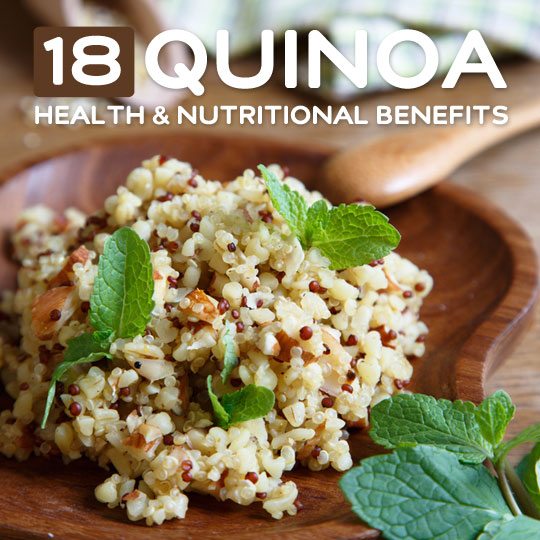
By now, you’ve probably at least heart about quinoa, no matter what your dietary habits are like. It’s a truly fascinating food, and worth taking a closer look at its different features and what it can provide for you. It’s been known in health circles for quite some time now, but has only received attention from the mainstream in recent years. Once you see what it can do, you’ll probably be adding it to your meals on a regular basis, and we’ve got you covered with our list of 101 Quinoa Recipes. In the meantime, check out this article about the top health benefits of quinoa!
[hr]
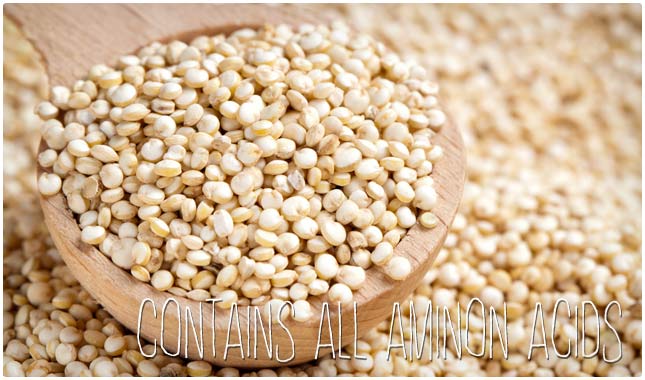
1. Contains All Amino Acids
One of the most impressive qualities of quinoa is its protein content. It’s not an animal source of protein but it boasts some pretty good numbers. The protein alone would be enough to eat it as it contains all of the essential amino acids that your body needs to truly function at its best. There are supplements out there that you can buy to get all of those amino acids in one place, or you can start eating quinoa daily to get them from a natural plant-based food source.
2. High in Fiber
The fiber content in quinoa is what gets many people interested in eating it. If you have trouble thinking of ways to increase your fiber and have resorted to buying and eating fiber bars or fiber fortified cereals to get the job done, you might be better off getting a supply of quinoa. Research shows that one cup of quinoa contains 11.9 grams of fiber, which is 48 percent of your daily recommended value! That’s pretty impressive considering that most quinoa recipes are filled with other foods like black beans that have a good amount of fiber so you can get a substantial portion of your fiber needs met in one meal. Check out our article on the top 11 reasons why you need more fiber in your diet.
3. High in Iron
For those that have trouble keeping up with their iron needs, quinoa can be a big help with that, and it also is a tastier option than taking an iron supplement. In just a one cup serving, you’re getting 7.8 mg of iron or 43 percent of your daily recommended intake. That’s a good boost to your system and can assist with any deficiencies. Getting enough iron is good for your brain and your muscles, and having the right amount will prevent anemia. Consider these other iron-rich veggies if you’re concerned about your iron levels.
4. High in Magnesium
Magnesium doesn’t get as much attention as some other vitamins and minerals do, but it’s still an important mineral that your body needs to help prevent things like osteoporosis and heart disease, while helping to balance blood pressure and helping with diabetes. You can get 335 mg of magnesium for every one cup serving of quinoa, which is 84 percent of your daily recommended intake. That’s pretty impressive since many foods only contain a trace amount of it, or none at all. If you feel like your levels could use a boost, try these other foods that are high in magnesium.
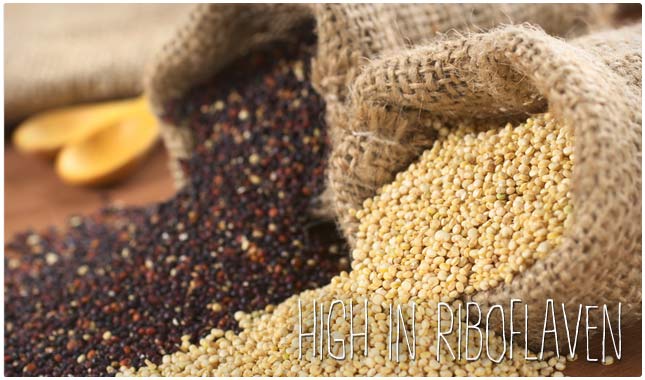
5. High in Riboflavin
Riboflavin is also known as vitamin B2. It’s part of the family of B vitamins and is responsible for providing much needed antioxidants to assist the body with a number of functions. It also helps with enzyme performance and oxygen delivery throughout the entire body. In other words, it’s a pretty important vitamin. A one-cup serving of quinoa contains 0.5 mg of riboflavin, which is 32 percent of your daily recommended intake. That might not sound like a lot, but many foods contain a bit of riboflavin, so it adds up throughout the day. Quinoa just gives it a nice contributing boost.
6. Rich in Manganese
Manganese is something you definitely don’t want to go without for any stretch of time, and with quinoa, you won’t have to because it provides more than what you need in one day with just one serving. Research shows that one cup of quinoa contains 3.5 mg of manganese, or 173 percent of your daily recommended value. The symptoms of being low on manganese include having high blood pressure levels, high cholesterol levels, neurological problems, hearing impairments, and more. The number one cause of running a manganese deficiency is not eating enough foods that are rich in it. That’s why making quinoa a part of your lifestyle is a good idea.
[hr]
7. Contains Lysine
One special amino acid that quinoa contains is called lysine. Lysine is usually found in sports supplements by those trying to add lean muscle to their body. It has been shown to help assist with the absorption of calcium and even prevent cold sores, so quinoa is great to eat during those months when everyone seems to be spreading germs. It has also been shown to help ease anxiety by binding to serotonin receptors in the body and helping you feel calm. Research shows that it can even help prevent stress-induced responses, such as diarrhea. Instead of taking a lysine supplement, try adding more quinoa to your diet.
8. Has Antiseptic Properties
Although the saponins in quinoa are considered an antinutrient, research shows that these compounds were once removed from the plant and used for their antiseptic properties to wash clothes and keep skin injuries clean. While you don’t want to swap out your current laundry detergent or soap for quinoa, there is evidence to show that saponins contain anti-bacterial properties that are effective against some resistant bacterial strains. Nowadays, saponins are avoided because they cause inflammation in the gut and inhibit the absorption of vitamins and minerals. If quinoa is hard for you to digest, try soaking it in water overnight. This deactivates the saponins and other hard to digest compounds to help alleviate some of the digestive discomfort.
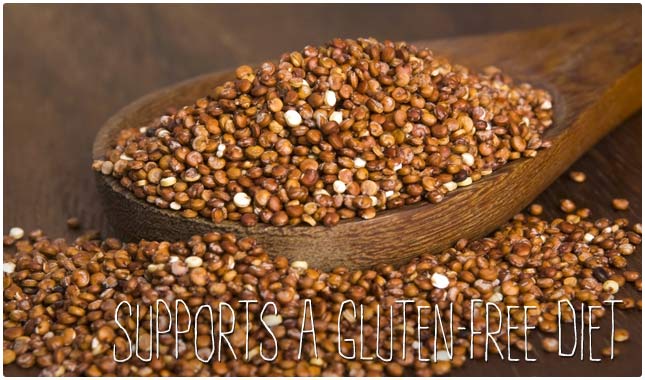
9. Supports a Gluten-Free Diet
When you’ve gone gluten-free either for medical reasons or for dietary ones, you’ll quickly find out that while there may be more GF options than there were a decade ago, there is still a lot of room for more products. In the meantime, you can stay gluten-free by using quinoa. Although it gets called a grain a lot, quinoa is actually a seed and it doesn’t contain any wheat or gluten in it, so you can feel free to enjoy it in loads of different quinoa recipes without worrying if it’s going to upset your system. Check out this list of yummy gluten-free foods that you can also add to your diet.
10. Low on the Glycemic Index
Quinoa clocks in at 53 on the Glycemic Index, which limbos under the 55 required to be considered a food that helps to stabilize your blood sugar. This makes it a good food if you’re trying to prevent getting diabetes, and you can combine it with any other foods that are also low on the GI scale so that you can nourish yourself without having to worry about spiking your blood glucose levels. Some diets, like the Paleo diet, consider a ranking of 53 high, so it’s all a matter of perspective and what your end goal is.
11. Contains Flavonoids
Research shows that quinoa contains antioxidant flavonoids, which can help reduce inflammation. These flavonoids can help with things like cardiovascular disease and other chronic conditions. This means that if you are at risk for heart disease or just want to do your best to prevent it, you can start eating more quinoa and be doing a great service in this regard.
12. Helps You Avoid Getting Fat
The fiber in quinoa helps the body get rid of unneeded fat, while also helping you to eat less by making you feel fuller longer. This will help you eat less overall, as well as help your digestive system process. The overall result is that if you have a problem with overeating, or a sluggish digestion, quinoa can help on both counts. The results of adding quinoa to your diet can typically be felt right away, as you start to feel lighter both by not eating as much, and having more regularity than you currently do.
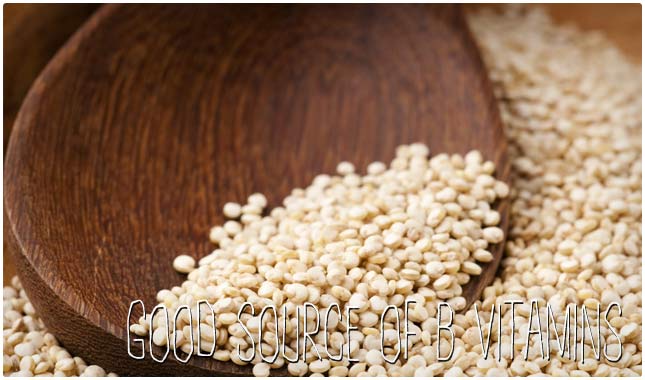
13. Good Source of B Vitamins
When compared to other grains, quinoa has a better B vitamin profile than most. Technically, it’s a seed, not a grain, but it most often gets compared to grains because of the way it is cooked and the texture it has when eaten. The B vitamin family helps with plenty of processes that the body goes through each day, and it’s important to stay topped up on them. Here are some other foods that contain a good amount of vitamins and minerals.
14. Potentially Anti-Inflammatory
Recent research is showing that quinoa may be an anti-inflammatory food, thanks to its flavonoid content. But at the same time, quinoa contains saponins, which have been shown to induce inflammation in some people with digestive disorders. Because of this, you may want to soak your quinoa overnight before cooking to make sure you’re getting the flavonoids without the saponins. It’s not very often that a food has this amount of healing properties, which makes it a bona fide superfood and one of the healthiest foods you can eat.
15. Helps Lower Cholesterol
It’s the fiber once again that provides the benefits here, this time helping to lower your cholesterol. Research shows that fiber helps lower LDL “bad” cholesterol levels. Many people resort to cholesterol-lowering drugs, and it’s always important to listen to your doctor’s advice. But with dietary changes and you doctor’s guidance you can avoid or reduce the amount of medication you have to take to keep your cholesterol in check. Quinoa makes it easy since it’s can be used in a myriad of ways, and you won’t feel like you’re eating a special diet of any sort, or missing out on the foods you love.
16. Helps Lower Blood Pressure
The fiber levels in quinoa have a direct effect on your blood pressure, in addition to the other benefits listed. The thing that prevents most people from getting enough fiber each day is that many of the sources are not considered very appetizing. But quinoa has a very delicate flavor, so you can mix it with just about any food you enjoy and you’ll get the flavor from that without the Quinoa getting in the way. It’s a very easy way to keep your blood pressure levels in check, without turning your world upside down.
17. Helps Balance Blood Sugar Levels
It’s not always eating foods that are sugar-free, or eating portion sizes that are considered small by American standards. Adding quinoa to a meal will help you keep your blood sugar levels in a happy place while at the same time getting your taste buds to agree. If you have a specific food or recipe that you normally can’t have, see if adding quinoa to it brings it down to the point where you can enjoy it without any trouble. If you find that you respond well to it you can start using it in more and more of your classic recipes.
18. Supports Weight Loss Efforts
If you’re on a diet, you’ll probably be allowed to eat quinoa on it, unless it’s a low carb diet. Some diets might say that you can’t have bread, or that you should avoid all wheat and grains. But that’s where quinoa comes in handy as it’s not a grain, contains no wheat, and bread made with quinoa is not likely the bread that you need to avoid. Because of its high protein content and great fiber levels, it gives a one-two punch to your weight loss goals, and has a host of other vitamins and minerals to keep you topped up and feeling good. The protein and amino acids will help with any weight training you’re doing, and the fiber keeps things moving internally.
[hr]
As you can see, it just makes nutritional sense to start eating more quinoa. You’ll end up feeling better, having more energy, and potentially losing weight just by switching other foods for quinoa. Quite frankly, foods like rice and noodles just can’t measure up as a side dish for all sorts of foods, and you’ll be getting a broader nutritional set from quinoa than you would from other foods. It’s not as hard to make as you might think, so be sure to check out our guide on How to Cook Quinoa so you can start tonight.



